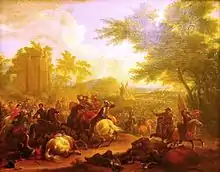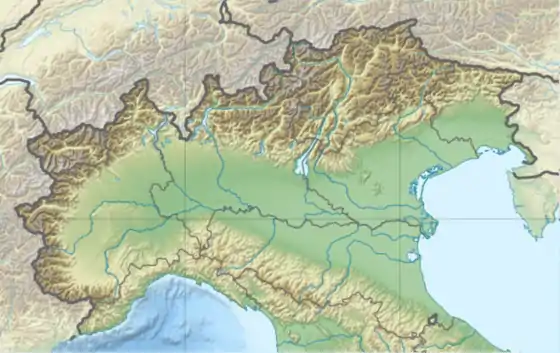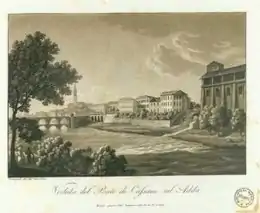Battle of Cassano (1705)
The Battle of Cassano took place on 16 August 1705, during the War of the Spanish Succession. It was fought at the town of Cassano d'Adda, in Lombardy, Italy, between a French army commanded by the duc de Vendôme and an Imperial army under Prince Eugene of Savoy.
| Battle of Cassano | |||||||
|---|---|---|---|---|---|---|---|
| Part of the War of the Spanish Succession | |||||||
 The bridge at Cassano, by Jean-Baptiste Martin, circa 1725 | |||||||
| |||||||
| Belligerents | |||||||
|
|
| ||||||
| Commanders and leaders | |||||||
|
|
| ||||||
| Strength | |||||||
| 22,000 | 24,000 [1] | ||||||
| Casualties and losses | |||||||
| 5,000 killed or wounded [2] |
4,000 killed or wounded 500 captured [3] | ||||||
By August 1705, the French occupied most of Savoy, with the exception of Turin. In order to relieve the pressure, Prince Eugene tried to cross the River Adda at Cassano, and threaten Milan. Although the French were taken by surprise, they managed to hold the bridge after six hours of intense conflict, both sides suffering heavy casualties.
The battle was inconclusive; while the French prevented the Imperialists crossing the Adda, Prince Eugene succeeded in delaying an assault on Turin until June 1706. Combined with having to transfer forces to Northern France following their defeat at Ramillies in May 1706, the French siege was broken in September, and fighting in Northern Italy ended in Match 1707.
Background
The War of the Spanish Succession was triggered by the death in November 1700 of the childless Charles II of Spain. He named his heir as Philip of Anjou, grandson of Louis XIV of France, and on 16 November 1700, he became king of the Spanish Empire. In addition to mainland Spain, this included the Spanish Netherlands, large parts of Italy, and much of Central and South America. In 1701, disputes over territorial and commercial rights led to war between France, Spain, and the Grand Alliance, whose candidate was Charles, younger son of Leopold I, Holy Roman Emperor.[4]
The war in Northern Italy centred on the Spanish-held Duchies of Milan and Mantua, which were considered essential to the security of Austria's southern borders. In March 1701, French troops occupied both cities; Victor Amadeus II, Duke of Savoy, allied with France, in return for which his daughter Maria Luisa married Philip V.[5]

In October 1703, Victor Amadeus renounced his alliance with France, and switched sides. During 1704, French Marshall La Feuillade captured Savoyard territories north of the Alps in Villefranche and the County of Savoy. By May 1705, Victor Amadeus controlled only Nice, his capital of Turin, and parts of Southern Piedmont.[6]
Despite their alliance, Leopold mis-trusted Victor Amadeus, whose ultimate goal was the Duchy of Milan, and focused on suppressing an uprising in Hungary. With Savoy close to defeat, he sent his best general, Prince Eugene, to resume command in Italy, along with men and money, a policy continued after his death in May by Emperor Joseph. England and the Dutch Republic also funded a contingent of 8,000 Prussians led by Leopold, Prince of Anhalt-Dessau, who reinforced the Imperial army.[7]
In July, Vendôme, French commander in Italy, captured Savoyard fortresses at Crescentino, and Chivasso. To relieve the pressure on Turin, Prince Eugene began marching along the right bank of the River Adda, seeking to threaten Milan. Vendôme positioned 20,000 men under his younger brother Philippe de Vendôme at Cassano d'Adda, the closest suitable crossing point, while he led a mobile reserve tracking the Imperialists along the left bank.[8]
When the Imperial army reached Iveza in the Brianza, they constructed a pontoon bridge under cover of artillery fire and Vendôme prepared to defend the crossing. This was a feint; after a perfunctory attempt to cross, Prince Eugene burned the bridge and headed towards Mantua. He then doubled back, hoping to catch the French detachment at Cassano by surprise before they could unite with the rest of the French army; on 14 August, he arrived in Romanengo, about 40 kilometres away.[9]
Battle

A deep and fast-flowing river, the Adda had limited crossing points, especially for large bodies of men. The town of Cassano was on the right bank, with a stone bridge protected by a small fortification or redoubt. The area was also divided by numerous small streams and irrigation channels, the most significant being the Retorto, an irrigation canal running parallel to the Adda. This was connected to the left bank by another bridge, protected by another strongpoint.[9]
Assuming Prince Eugene was still heading for Mantua, Vendôme ordered his brother Philippe to leave his positions around Cassano, and intercept him. In fact, the Imperial troops had marched overnight from Romanengo, and were approaching the town when spotted by one of Vendôme's cavalry patrols early next morning. Realising their intentions, Vendôme headed to Cassano, along with around 2,000 reinforcements.[10]
On arrival, he found Philippe's troops unprepared, and in an extremely dangerous position, the bulk of their force caught between the Retorto canal and the Adda, and the main bridge blocked by their transport. Vendôme ordered the baggage thrown into the river, and formed a line running from the Retorto on the left, his centre around the main bridge, and his extreme right resting on the road leading to the nearby village of Rivolta d'Adda. Armand St Hilaire, the French artillery commander, positioned his guns inside the town, allowing him to fire directly on the bridge.[11]
Around 14:00, Austrian grenadiers attacked the French positions around the Retorto; they initially succeeded in capturing the bridge, before being repulsed by St Hilaire's guns, and a counter-attack. Vendôme sent four regiments of the French Irish Brigade to reinforce his left, but after a fierce struggle, the Imperialists captured the canal's sluice gates. After these were closed, the water level in the canal was lowered enough for men to wade across it.[12]
Prince Eugene ordered Leopold and his Prussians into the canal to assault the French left; they managed to seize the further bank, but suffered heavily in doing so. The battle surged back and forth across the river for several hours, in the course of which Vendôme had his horse killed under him, while Prince Eugene was wounded twice and had to leave the field. The fighting lasted another four and five hours, until ended by sheer exhaustion, with the opposing forces back at their starting positions.[13]
Aftermath

Nearly 25% of the forces engaged became casualties, the French losing around 5,000 killed or wounded out of 22,000, while of 24,000 Imperialists involved, over 4,000 were killed or wounded, with another 500 captured.[3] Prince Eugene claimed it as a victory, since he achieved his aim of delaying the Siege of Turin until June 1706; historian John A. Lynn considers it a 'minor French tactical victory', but essentially inconclusive.[14]
The two sides spent the next few weeks watching each other; Prince Eugene quickly recovered from his injuries and in early October began building barracks at Treviglio to make it seem he had decided to stay there for the winter. Vendôme returned to Southern Piedmont to meet with La Feuillade, but it was now October, and they decided it was too late in the year to attack Turin. Nevertheless, Victor Amadeus' position remained precarious; in December, Nice finally surrendered, and his possessions north of the Alps were held by France until the end of the war.[6]
Defeat at Ramillies in May 1706 forced Louis XIV to recall Vendôme from Italy, leaving the less competent La Feuillade in command. Prince Eugene broke the siege in September, France withdrew to focus resources on their northern border, and fighting in Northern Italy ended in March 1707.[15]
References
- Nolan 2008, p. 72.
- Jones 1997, p. 286.
- Clodfelter 2002, p. 73.
- Somerset 2012, p. 168.
- Dhondt 2015, pp. 16–17.
- Symcox 1983, p. 149.
- Wilson 1998, p. 120.
- O'Conor 1845, p. 299.
- A Brief Historical Sketch of the Irish Infantry Regiment of Dillon and the Irish Stuart Regiments in the Service of France, 1690–1791 1905, pp. 302–305.
- De Périni 1896, p. 145.
- De Périni 1896, p. 146.
- Bancks 1745, p. 195.
- O'Conor 1845, pp. 301–310.
- Lynn 1999, p. 301.
- Lynn 1999, p. 310.
Sources
- "A Brief Historical Sketch of the Irish Infantry Regiment of Dillon and the Irish Stuart Regiments in the Service of France, 1690–1791". Royal United Services Institution. Journal. 49 (325): 302–305. February 1905. doi:10.1080/03071840509418684.
- Bancks, John (1745). The history of Francis-Eugene Prince of Savoy (2010 ed.). Gale ECCO. ISBN 1170621236.
- Clodfelter, Micheal (2002). Warfare and Armed Conflicts: A Statistical Reference to Casualty and Other Figures 1500-1999. McFarland & Co. ISBN 978-0786412044.
- De Périni, Hardÿ (1896). Batailles françaises, Volume VI 1700-1782. Ernest Flammarion.
- Dhondt, Frederik (2015). De Ruysscher, D; Capelle, K (eds.). History in Legal Doctrine; Vattel and Réal De Curban on the Spanish Succession; the War of the Spanish Succession in Legal history; moving in new directions. Maklu. ISBN 9789046607589.CS1 maint: ref=harv (link)
- Falkner, James (2015). The War of the Spanish Succession 1701-1714 (Kindle ed.). Pen and Sword. ISBN 9781473872905.
- Jones, Archer (1997). The Art of War in the Western World. Barnes and Noble. ISBN 978-0760707340.
- Lynn, John (1999). The Wars of Louis XIV 1667-1714. Longman. ISBN 0582056292.
- Nolan, Cathal (2008). The Wars in the Age of Louis XIV, 1650-1715: An Encyclopedia of Global Warfare and Civilization. Greenwood. ISBN 978-0313330469.
- O'Conor, Matthew (1845). Military History of the Irish Nation: Comprising a Memoir of the Irish Brigade in the Service of France; (2017 ed.). Forgotten Books. ISBN 1330370775.
- Somerset, Anne (2012). Queen Anne; the Politics of Passion. Harper. ISBN 978-0007203765.CS1 maint: ref=harv (link)
- Symcox, Geoffrey (1983). Victor Amadeus II: Absolutism in the Savoyard State, 1675-1730. Thames and Hudson. ISBN 978-0500870105.
- Wilson, Peter (1998). German Armies: War and German Society, 1648-1806. Routledge. ISBN 1857281063.